Keeping it in the family with the best value second wine picks
Further informing your Bordeaux 2020 purchases, we look at the top 20 second wines of the vintage by Wine Lister’s value score. The score is calculated based on the quality to price ratio of a wine and vintage, while still allowing room for higher-priced wines to feature.
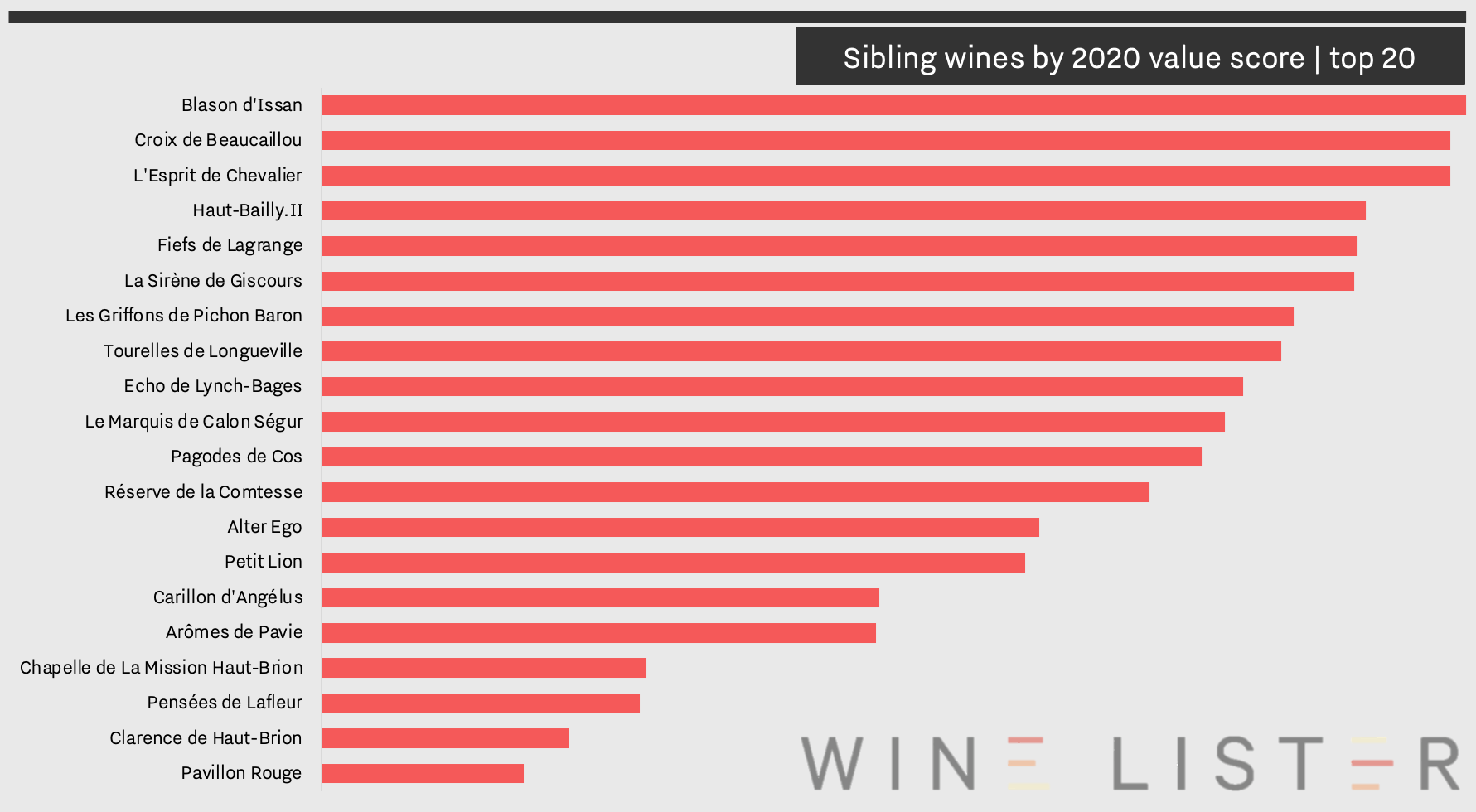 The top 20 leading sibling wines by Wine Lister value score
The top 20 leading sibling wines by Wine Lister value score
Which second wines provide the greatest value?
Often lurking in the shadows of their Grand Vin counterpart, sibling wines offer a high quality, more accessible alternative to Bordeaux’s long-ageing elite. While some are the product of grapes remaining from the Grand Vin, other producers prefer to give a sibling wine its own dedicated plots, often of slightly younger vines. In either case, these wines made at the hands of some of the world’s greatest winemakers should be considered seriously. Below we look at our top picks of sibling wines for value, based on the latest offerings from the Bordeaux 2020 en primeur campaign.
Left Bank legacies
All major Bordeaux appellations across both banks are well-represented amongst the top 20 value picks, with Margaux property, d’Issan achieving the greatest value score for the 2020 vintage. First produced in 1985, Blason d’Issan bears a greater proportion of Merlot than its Grand Vin sibling (57% compared to 39%), but as noted by its maker, Emmanuel Cruse, is still very much a “baby d’Issan”, sporting the château’s perennial style. The second wine of 2020’s wine of the vintage (according to Wine Lister partner critics), Margaux, has been a permanent feature of the estate since the 17th century; christened Pavillon Rogue in 1908, it is 2020’s only top 20 second wine from a First Growth property. Margaux comrade, Giscours, is also represented, by its Sirène de Giscours, which enjoys the same winemaking attention and ageing as the Grand Vin, but with grapes sourced from younger vines. Finally, Margaux majesty, Palmer is featured with Alter Ego. Its 2020 release was well sought-after, particularly after no second wine was produced in 2018.
Pessac-Léognan royalty, Haut-Brion’s Clarence de Haut-Brion ranks among the top 20 sibling wines for value. It is joined by L’Espirit de Chevalier – the red counterpart of Domaine de Chevalier’s sibling series – and Haut-Bailly’s Haut-Bailly II. The latter was renamed (from La Parde de Haut-Bailly) in 2019 to symbolise the second generation of owners, the Wilmers family. Finally, Chapelle de La Mission Haut Brion comes from the same vineyard as the Grand Vin, grown and harvested in the same way, with the introduction of grapes from the older parcels of La Tour Haut-Brion since the 2006 vintage.
Saint-Julien has three properties represented by their second wines, including Croix de Beaucaillou, which ranks in second place. This sibling wine is produced using grapes hailing from its own distinct vineyard, lying to the west of the château. Completing the top five rankings is Fiefs de Lagrange, which bears familiarity to its Grand Vin sibling, but is more suited for earlier drinking. Finally, Léoville Las Cases’ le Petit Lion celebrates its 13th vintage with the release of the 2020, produced from a blend of replanted vines that are now between 15 and 18 years of age.
In neighbouring Saint-Estèphe, Le Marquis de Calon Ségur and Pagodes de Cos occupy 10th and 11th place respectively, with the former taking very different form from their first wine as an alternative interpretation of the Calon terroir. The latter is produced from a separate, dedicated plot of 40-year-old vines.
Completing the Left Bank selection are four Pauillac value picks, of which two hail from the same property. Pichon Baron is the only property to see its two additional wines feature – Les Griffons de Pichon Baron and Tourelles de Longueville. Lynch-Bages’ Echo joins them within the top 10 picks by value score. Finally, Pichon Comtesse’s Réserve de la Comtesse – first sold in 1973 – is a top feature for en primeur 2020. This well-established sibling wine represents between 20% to 50% of Pichon Comtesse’s total production.
Right Bank relatives
One the Right Bank, and particularly in Pomerol, sibling wines have been slower to catch on, simply due to lower production levels per property. Two Saint Emilion Classés A properties nonetheless stand out for sibling value picks– Pavie and Angélus – featuring Arômes de Pavie and Carillon d’Angélus, respectively. The latter is increasingly becoming a “cousin” rather than a sibling, since the property has recently invested heavily in new plots for Carillon alone. Amongst this top pick hoard is Pomerol estate, Pensées de Lafleur, which takes 13th place amongst the top value picks with a limited-production of 500 cases.
Change and adaptation on the banks of Bordeaux
Unpicking the challenges of the 2020 growing season, we talk to seven top Bordeaux producers to understand more about how climate change continues to impact the region’s fine wine industry.
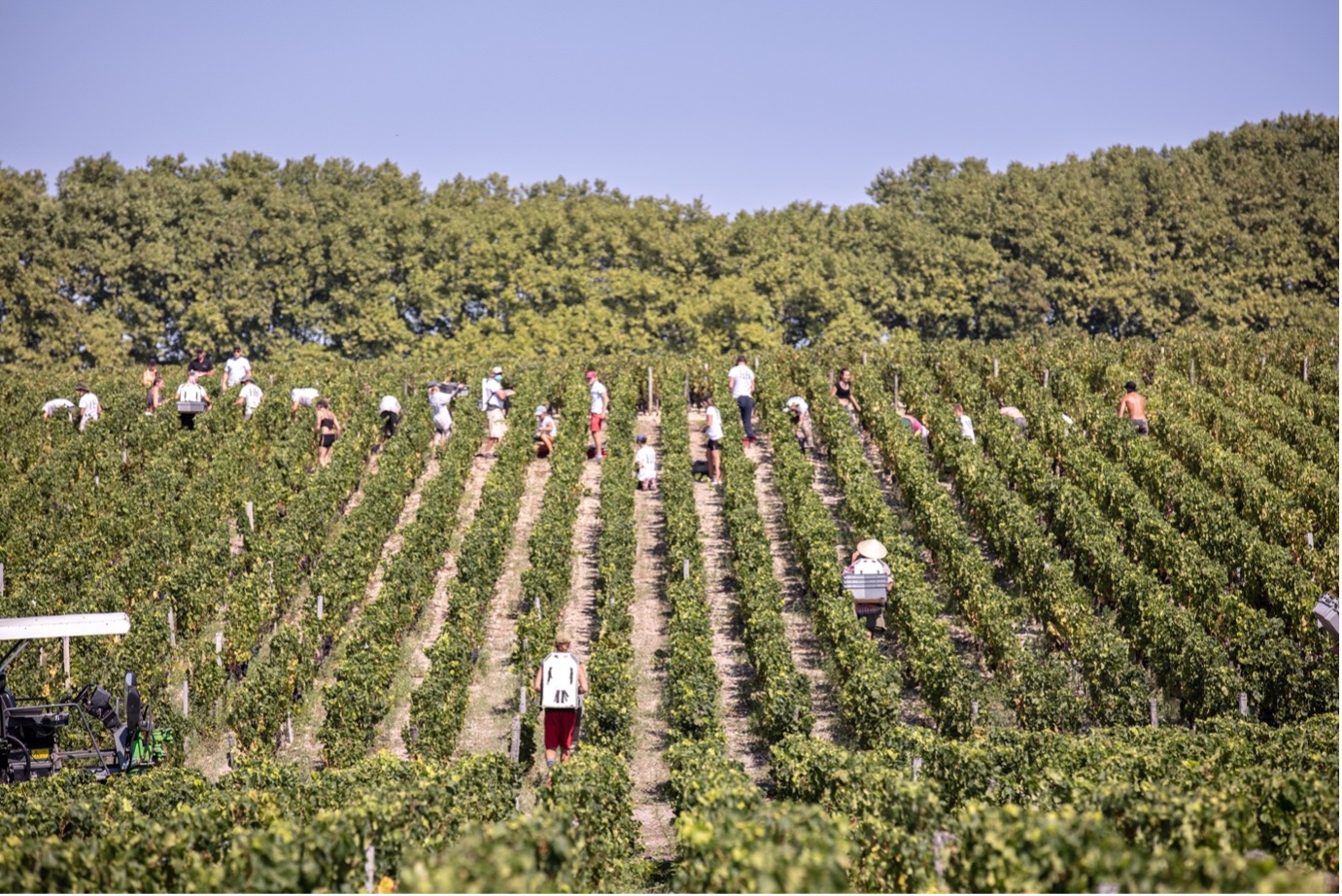 Haut-Bailly harvest under the scorching September sun
Haut-Bailly harvest under the scorching September sun
How is Bordeaux adapting to climate change?
Bordeaux has been no stranger to extreme climatic conditions in recent years, culminating in what some may describe as climatological confusion for many châteaux last year. While witnessing 15% more rainfall between March and September 2020 than its 30-year average for this period, Bordeaux also saw 54 days of excessive drought during the summer. It would appear that now, more than ever, adaptation and innovation are key to the successes of the region’s releases.
Dealing with drought
- Extensive dry spells have become a common phenomenon in Bordeaux, with Margaux’s Business Development Director, Alexis Leven-Mentzelopoulos, sharing with us his concerns that the vines “could end up with wilting” leaves, leading to “a loss in terms of yields but also eventually in terms of quality”. Despite also being one of the wettest years on record, 2020 was no exception with its pattern of heatwaves and ensuing drought.
- Saint-Émilion’s Cheval Blanc experienced its driest vintage since 1959, though Technical Director Pierre-Olivier Clouet explains the humid spring fortunately allowed the vines to accumulate “water and nutrients much needed later in the season”. He elaborates that despite the drought, this allowed vines to “grow calmly and homogenously”.
- Across the Gironde, Haut-Bailly’s Véronique Sanders tells us that “work in the vineyards has evolved enormously”, and that “the fundamental process of pruning has been re-examined” as part of a wider series of viticultural practices that have been changed to adapt to climate change, enabling Haut-Bailly to make the most out of the varied conditions.
Coping with concentration
- Several properties such as Larrivet Haut-Brion saw small and concentrated berries as a result of high temperatures and persistent drought in 2020. The estate’s Cellar Master, Charlotte Mignon tells us that it has had to adapt its winemaking in recent years, opting for punching down versus pumping over in order “to control light and elegant extractions” in such hot years.
- Alexis similarly tells us of Margaux’s recent investment in more highly advanced phenolic analysis equipment, which reports the levels of tannin and pigment in the individually-vinified lots and allows the team to “precisely plan extraction with lower temperatures, fewer and gentler pump-overs, and limited maceration time”.
- Increasingly concentrated grapes have also reduced yields across the region, as told to us by Calon Ségur’s Managing Director, Vincent Millet, whose volumes in 2020 fell to 33hl/ha (down from 40hl/ha in 2019) due to the heat.
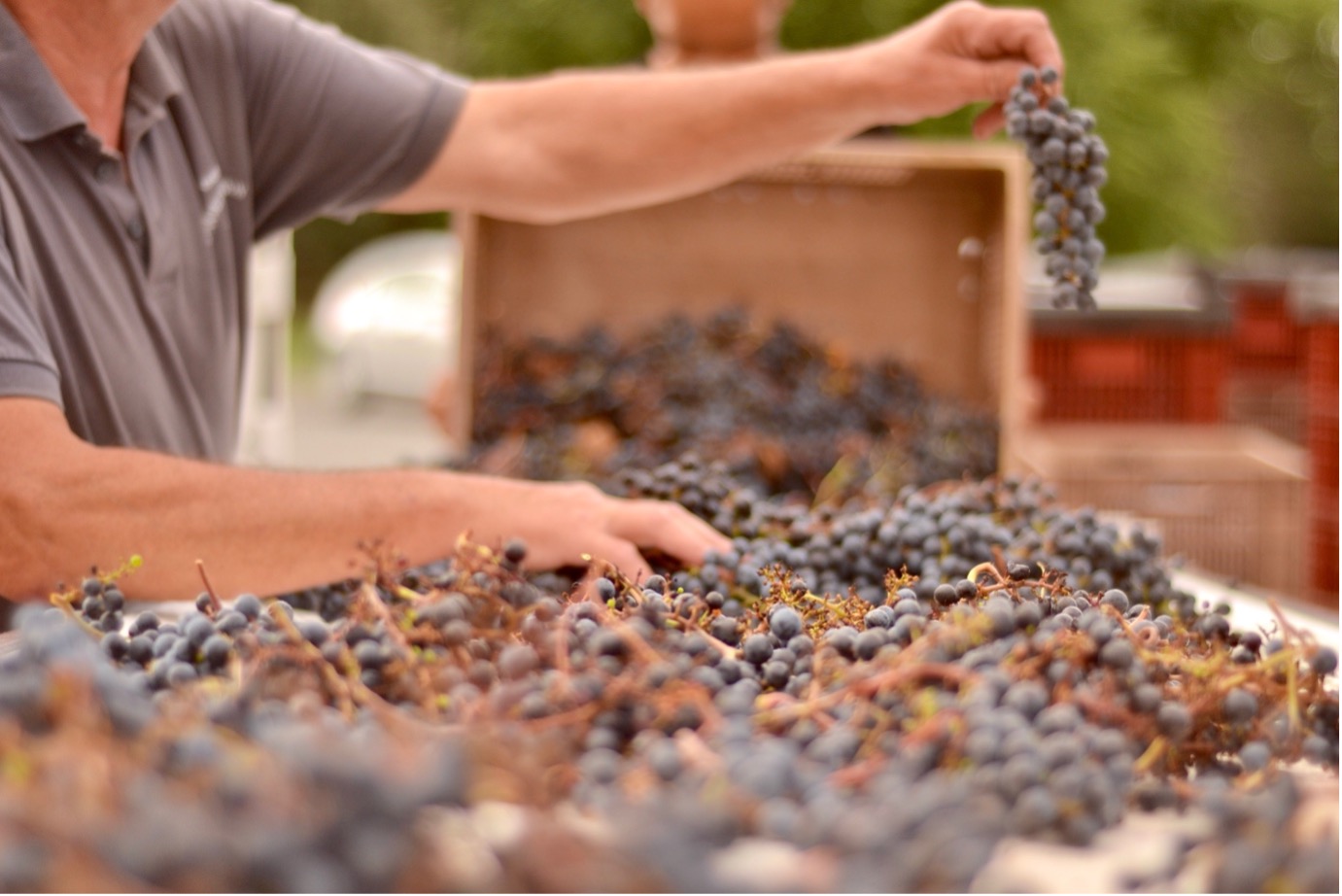 Larrivet Haut-Brion incorporating recently harvested whole bunches into their blend
Larrivet Haut-Brion incorporating recently harvested whole bunches into their blend
A move away from Merlot
- With global warming affecting the evolution of certain grape varieties, Palmer CEO, Thomas Duroux tells us that the “classic complex finish of Merlot” is particularly threatened by rapid ripening induced by hot summers.
- This concern was shared amongst several properties, with Charlotte finding Larrivet Haut-Brion’s Merlot grapes to be heavier, with greater sugar levels and thus a higher alcohol potential. To regain freshness in their Merlot juice, she now “incorporates the whole grape bunch, including the stalk”, to add more structure and tannins. In the long term, the estate is planning to replant more plots to Cabernet Sauvignon due to the varietal’s slower ripening, while Margaux is similarly including “more and more” Cabernet Sauvignon and Cabernet Franc in their blend, and “even thinking of perhaps experimenting with a few rows of Carménère”, to study how it reacts to high temperatures.
- In similar vein, Claire Villars-Lurton of Ferrière remarks on the advantage of less Merlot in the changing climate: “We have prioritised replanting of Cabernet Sauvignon, rather than Merlot, as even young the latter variety is more sensitive to water stress”.
Nourishing nature
- Several of the châteaux we spoke to highlighted their aim of counteracting the effects of climate change by enriching the natural environment and the soil. Thomas emphasises the importance of having a “living soil” in the face of ecological stress, noting that biological compost and plant growth amongst the vines offers “greater stability, root resilience, and nourishment” in increasingly hot and dry years.
- The benefits of a living soil are echoed by Vincent, who tells us that at Calon Ségur they plant grass cover in the vine rows maintains “some moisture in the soil during dry periods”.
- Claire notes that cover crops help to maintain soil biodiversity, but the approach she takes goes beyond this purpose: “we adopt a minimal intervention approach in the vines. We plant cover crops between the rows, that we fold over or cut so as to have a natural mulch – this protects the soil from the damaging effects of strong sunlight, allows the soil to keep a good level of humidity, and means any rain that falls can seep deeper into the subsoils”.
Shading from the sun
- Like several châteaux adapting viticultural practices vintage-by-vintage, Larrivet Haut-Brion withheld leaf removal until later in the 2020 growing season, to shelter grapes from the scorching sun.
- A similar strategy has been adopted at Haut-Bailly, who revise their canopy management every year to reflect the concurrent needs of vines.
- At Calon-Ségur, Vincent explains they are “careful about thinning out the leaves in order to avoid burns”, and are considering “adjusting the height of the trellis” to provide shade from one row to another. Opting for a more permanent solution, Margaux have gone so far as to “change the orientation of the vine rows” in order to “expose each side of the vine to the heat equally and minimize sunscald”.
As well as gaining top scores across its reds, Bordeaux 2020 was successful for dry whites, notably at the highest level. Helping you to discover some of the leading examples, we explore the top five Bordeaux 2020 dry white wines by WL score.
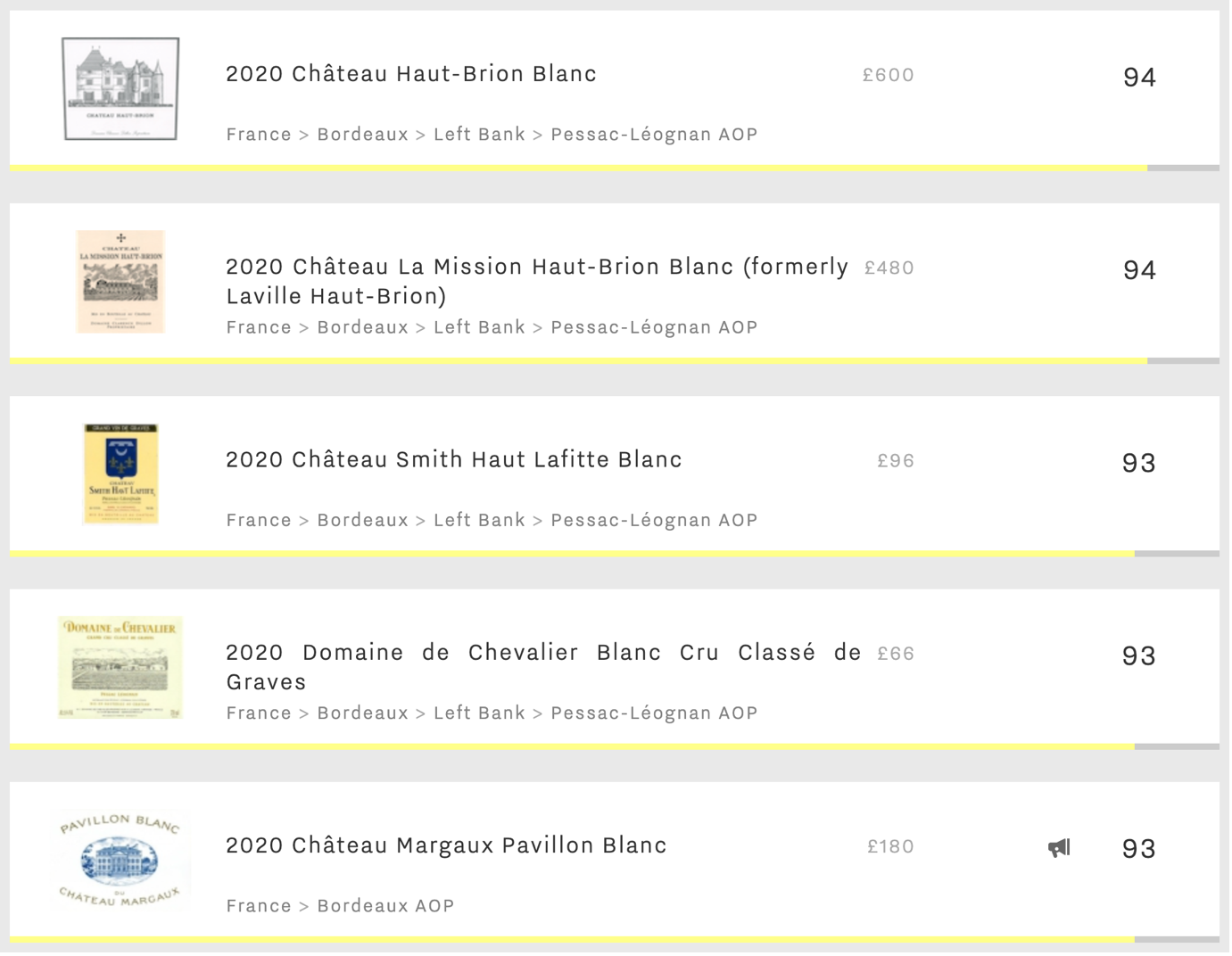 The top dry Bordeaux whites of the 2020 vintage, displayed in order of WL score
The top dry Bordeaux whites of the 2020 vintage, displayed in order of WL score
Will 2020 be a good vintage in Bordeaux for dry white wines?
Despite another exceedingly warm growing season in 2020, Bordeaux’s earlier-ripening white grapes fared well across many of the region’s top blanc producers. Having seen one of the earliest harvests on record, the first Sauvignon Blanc grapes were picked on the 14th of August, and all fruit destined for dry whites was harvested by early September. The white Bordeaux vintage therefore avoided high temperatures during the rest of the month, maintaining balance and freshness.
With a remarkably small production of just c.600 cases per annum, Haut-Brion Blanc remains one of the most sought-after Bordeaux dry whites. To combat the warm summer temperatures, the team conducted pre-dawn harvesting, picking grapes during the cooler night-time climate to ensure better levels of acidity and freshness. Wine Lister CEO, Ella Lister, found Haut-Brion Blanc to show “an almost Burgundian minerality accompanying its unmistakable Pessac green and yellow-fruit character”. With a WL score of 94, it champions the leader board of Bordeaux dry whites for the last four vintages, and there is still some of the 2020 available to purchase en primeur at IG Wines for £600 per bottle (in-bond).
Haut-Brion’s sibling estate, La Mission Haut-Brion’s white is characterised by a Sémillon-dominated blend – a grape with naturally low acidity compared to Bordeaux’s other white varietals. With soaring summer temperatures in 2020, the team therefore increased the percentage of Sauvignon Blanc in its blend to 54.7% (up from 30.1% in 2019) to ensure balance. Ella notes the impact of the increased Sauvignon on the wine’s acidity, describing a “zippy acidity, zingy energy, [with a] peach stone finish.” La Mission Haut-Brion’s white gains a WL score of 94 for the 2020 vintage, and can be found at Justerini & Brooks for £480 per bottle (in-bond).
Smith Haut Lafitte Blanc’s white vines are planted just behind the château to the north, where they benefit from a cooler microclimate that withstood high temperatures in 2020. Technical Director, Fabien Teitgen found a “nice balance and liveliness” in the grapes after harvest, while Ella characterises the 2020 as “subtle and flirtatious, building slowly into notes of white pepper and lime, as well as pure white fruit”. Gaining a WL score of 93, Smith Haut Lafitte blanc 2020 is available at Honest Grapes for £96 per bottle (in-bond).
Located at the heart of the Landes pine forest, Domaine de Chevalier’s vines are also subject to a cooler microclimate as a result of the surrounding woodland, which was certainly welcomed in 2020. When sampling the latest release at the estate, Ella enjoyed the richness of the vintage, noting “Aromas of tangerine, white flowers, custard, and acacia honey” and a palate that is “creamy and caressing […] with a lift of tension and a savoury bite.” Receiving a WL score of 93, Domaine de Chevalier Blanc 2020 can be acquired from Berry Bros & Rudd for £68 per bottle (in-bond).
Though First Growth Margaux has been producing a dry white for over 300 years, Pavillon Blanc 2020 marks the 100th anniversary under its current name. The only non-Pessac pick to feature in the top-five ranking, the success of the latest release was not without its challenges. Tasting alongside Margaux’s Managing Director, Philippe Bascaules, and Business Development Director, Alexis Leven-Mentzelopoulos, Ella was informed of the high mildew pressure as a result of a hot wet spring in 2020, which risked affecting the Sauvignon Blanc grapes of their single-varietal wine. Nevertheless, their 2020 receives a WL score of 93, with Ella describing a “Really rich, mouthcoating texture on entering the mouth – almost a Chardonnay-esque opulence”, and declaring the wine “Delicious.” Pavillon Blanc 2020 can be purchased en primeur from Goedhuis & Co for £180 per bottle (in-bond).
New additions from this year’s offerings
With the Bordeaux 2020 en primeur campaign now concluded, Wine Lister’s latest MUST BUY update includes 13 new picks from the latest vintage, covering a range of different appellations and price points.
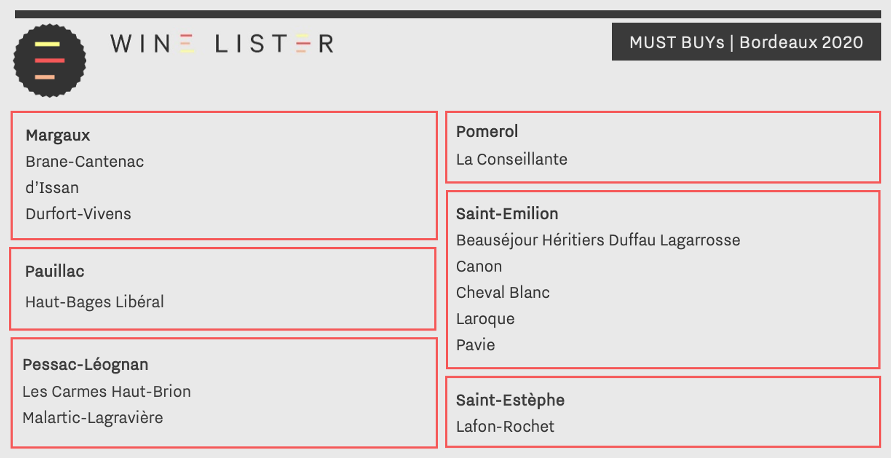 New 13 MUST BUY additions from Bordeaux 2020
New 13 MUST BUY additions from Bordeaux 2020
What are the MUST BUYs from Bordeaux 2020?
Wine Lister’s MUST BUY algorithm takes into account a wine’s quality and value within its vintage and appellation to produce initial recommendations. These results are then filtered through an intelligence-based, human overlay, which identifies MUST BUY wines based on our tasting of Bordeaux 2020, and observation of the reception of each release in the market.
Right Bank insights
Highlighting the success of the Right Bank in 2020, Saint-Emilion houses five of our 13 Bordeaux 2020 MUST BUYs. Amongst the selection is one of Wine Lister partner critic, Antonio Galloni’s (Vinous) “wines of the year”, Pavie 2020, which he scores 97-99, noting “All the elements are well balanced.” The first key release out of the gate this year, Cheval Blanc also gains MUST BUY status. With a score of 96-98 from Neal Martin (Vinous), who calls it “finely proportioned and multi-layered” with a “mineral-driven finish”, the 2020 can be purchased en primeur from Petersham Cellars for £388 per bottle (in-bond).
Beauséjour Héritiers Duffau Lagarrosse, Laroque, and Canon also join the Saint-Emilion entries – the latter gaining praise from Wine Lister CEO, Ella Lister, who describes it as “Full-to-bursting with salivating fruit, just ‘à point’, with impeccable balance”. Canon 2020 can be bought en primeur from £96 per bottle (in-bond) from Honest Grapes.
The Right Bank is represented further by prized Pomerol property, La Conseillante, which retains MUST BUY status for the second vintage in a row. Released at £156 per bottle (in-bond), the 2020 receives a score of 96-98 from Neal Martin, who calls it a “deeply impressive and quite profound La Conseillante”, and is available to purchase en primeur from Goedhuis & Co.
Left Bank investments
Over on the Left Bank, the latest Margaux MUST BUYs comprise 2020s from Brane-Cantenac, d’Issan, and Durfort-Vivens – all of which are available on the market for £50 per bottle (in-bond) or less. d’Issan performs notably well, taking new shape with the introduction of Petit Verdot and Malbec in the latest blend, hailing from new plots purchased by the estate in March 2020. It earns a score of 93-95 from Antonio Galloni, who notes that “Issan is shaping up to be a jewel of a wine.” Appearing in the rankings for most-improved Wine Lister Quality score for a third consecutive year (see our recent blog here), Durfort-Vivens also achieves MUST BUY status in 2020. The estate has seen impressive post-en primeur price performance in recent years, and shows future promise in its upward quality trajectory. Durfort-Vivens’s latest release can be bought en primeur from Justerini & Brooks at £44 per bottle (in-bond).
Pauillac’s Haut-Bages Libéral 2020 receives some of the highest scores ever achieved by the property, including a score of 17 from James Lawther for JancisRobinson.com, who calls it “pure and precise” with “silky and refined” tannins. In neighbouring Saint-Estèphe, Lafon-Rochet also features in the latest MUST BUY haul, with a vintage that marks the inaugural merging of two of the most revered minds in Bordeaux (see our recent blog here). Jean-Claude Berrouet and Eric Boissenot’s joint efforts in 2020 were praised by critics, with Jancis Robinson calling it “a very successful 2020.” Released from £27 per bottle (in-bond), Lafon-Rochet 2020 also gains Value Pick status, and can be purchased at Jeroboams.
Pessac-Léognan provides two MUST BUYs in 2020, with Malartic-Lagravière receiving a score of 93-95 from Antonio Galloni, who describes it as having “An extra kick of energy and vibrancy that is quite attractive”. Les Carmes Haut-Brion 2020 earns 95-97+ from the critic, and can be acquired from Jeroboams for £79 per bottle (in-bond).
Explore all Wine Lister MUST BUYs here, or discover more Bordeaux 2020s here.
Bordeaux en primeur 2020 saw mixed pricing decisions throughout the campaign. To help those still looking to purchase en primeur this year, we examine some of the best offerings from the latest vintage at five different price points. (All prices are quoted in-bond per bottle when purchasing by the case).
Click here to view all Bordeaux 2020 releases, or read more below.
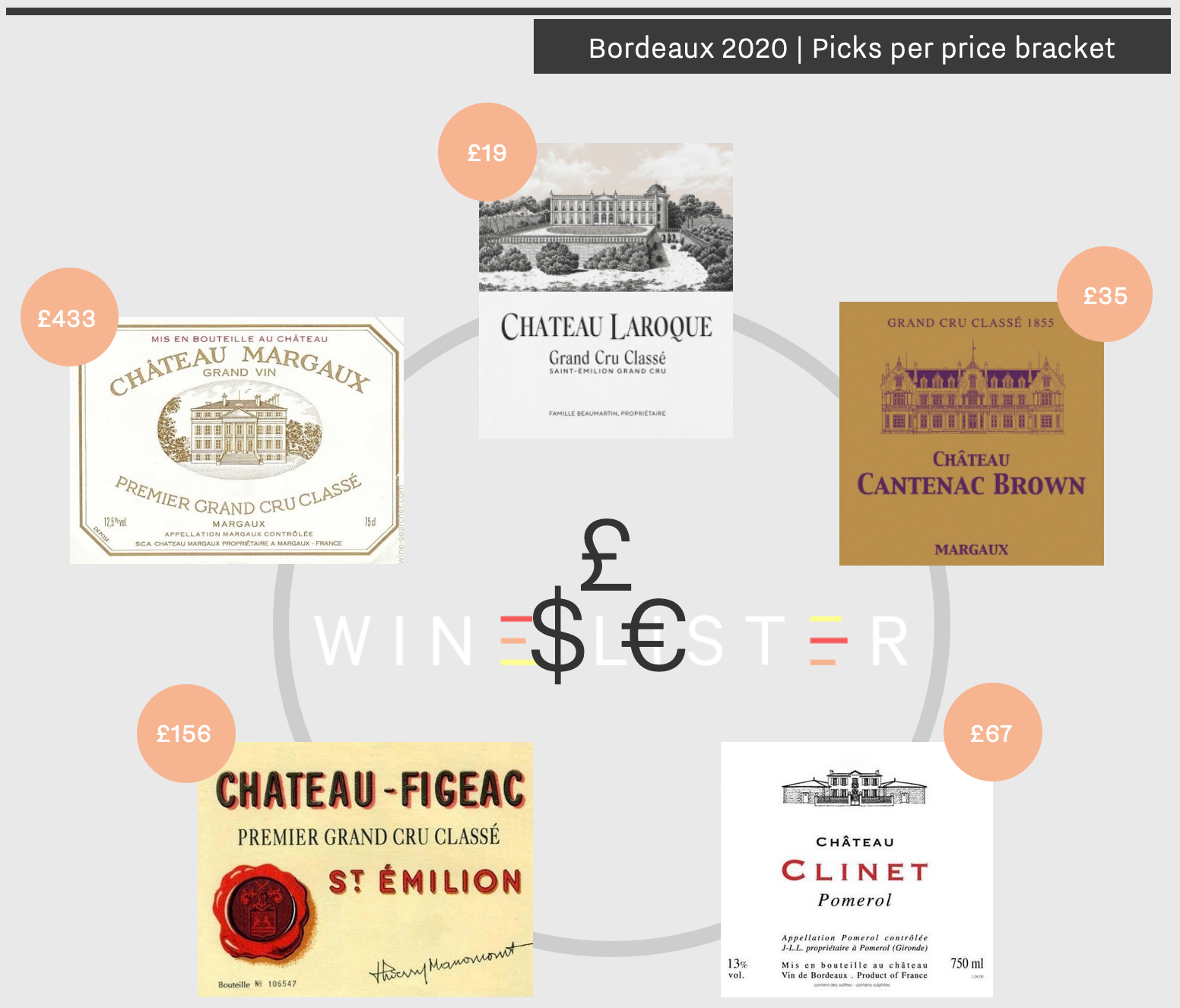
Under £20 – Laroque
Attesting to the estate’s sustained step-up in quality since its 2018 vintage, Laroque receives strong critical praise in 2020. Antonio Galloni and Neal Martin (Vinous) both award 93-95, with the latter calling it, “Possibly the best Laroque that winemaker Suire has overseen to date.” Having worked at fellow Saint-Émilion estates, Bellevue, Beauséjour Héritiers Duffau Lagarrosse, and Larcis Ducasse over the past 15 years, winemaker David Suire joined Laroque in 2015. He has since invested in making significant quality improvements, changing the winemaking process of the Grand Vin to now consist solely of free-run juice and no press wine. The third Laroque release in a row to achieve Value Pick status, the 2020 vintage can be bought from Justerini & Brooks for £18.92 per bottle (in-bond).
Under £50 – Cantenac Brown
The recent acquisition of Margaux Third Growth, Cantenac Brown, by agro-engineer, Tristan Le Lous, brought about a buzz of excitement for his first full vintage at the estate. Under its new ownership, the estate has expanded its vineyards by 9.5ha to incorporate high-quality vines from neighbouring estates, La Galiane and Charmant on the iconic Margaux plateau. Efforts to improve their blend, through the introduction of 70% of the grapes harvested on these new parcels, are reflected in top scores for the 2020 vintage, which receives its highest ever score from Antonio Galloni (94-97). Tasted by Wine Lister CEO, Ella Lister, she calls it, “A very successful Cantenac Brown.” Cantenac Brown 2020 can be purchased en primeur from Goedhuis for £34.33 per bottle (in-bond).
Under £100 – Clinet
Pomerol’s rising star, Clinet once again provides good value within its appellation in 2020. With traces of the vineyard dating back to 1595, one of Pomerol’s oldest estates is managed under the watchful eyes of a small team, co-headed by President of the UGCB, Ronan Laborde. Receiving a score of 94-96 from Neal Martin, he notes, “This is a Pomerol that really wants to make an impression.” Ella found the 2020 vintage to be, “Seamless and languorous. A triumph.” Clinet 2020 is available en primeur at IG Wines for £66.50 per bottle (in-bond).
Under £200 – Figeac
Completing a trilogy of top-scoring vintages, Figeac 2020 highlights the estate’s skilled adaptation to the extreme climate conditions it faced in the year. The team recently reflected on the challenges brought about by “mild winter temperatures, summer heat-waves, and unusually variable rainfall” in 2020, which nonetheless produced one of Ella’s favourite wines from the vintage. Tasting in Bordeaux, she notes a “Trademark Figeac texture. The harmony is mind-blowing.” This Saint-Émilion star can be purchased en primeur from Farr Vinters for £156 per bottle (in-bond).
Over £300 – Margaux
Margaux is one of Wine Lister’s top picks at the premium end of the en primeur spectrum. The highest-scoring wine of the vintage, Margaux is the only 2020 to receive a WL score of 98 (an average combining all Wine Lister’s partner critics on a 100-point scale). According to the Margaux team, the success of the vintage is down to the amalgamation of “homogenous flowering, summer conditions that favoured small berries, and excellent harvesting conditions.” Indeed, the 2020 receives a score of 19 from James Lawther for JancisRobinson.com, who describes it as the “Perfect pitch”, while Ella was “Wowed”, stating “This will age into eternity, and yet the texture is already soft now.” For those looking to find this First Growth, Margaux 2020 can be reserved for £433 per bottle (in-bond) via Petersham Nurseries.
Part II of Wine Lister’s annual Bordeaux Study, “Going the (quality distance)”, explores the outperformers of the latest vintage – the top 15 wines whose Wine Lister Quality score (part of our Pro rating system) in 2020 most exceeded their wine-level average.
Read on below to find out more, or head to our analysis page to download the Bordeaux Study here.
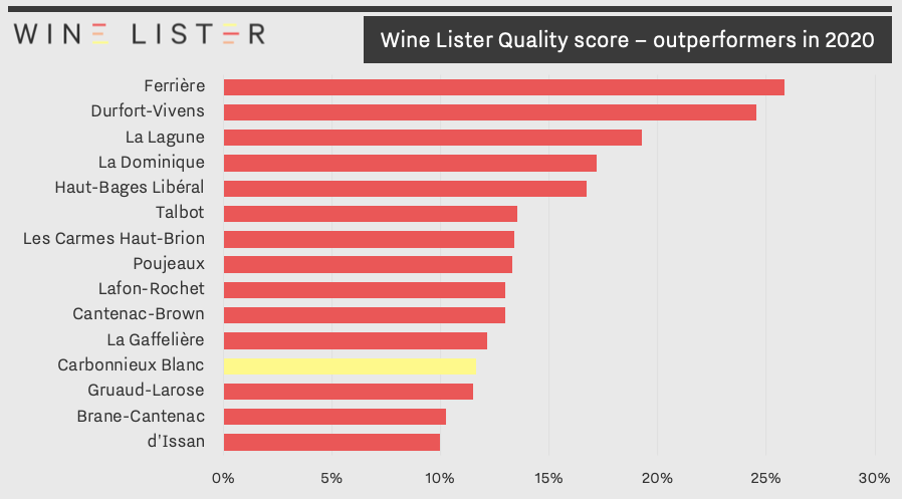
Margaux is well-represented in the 2020 outperformers chart, with five wines showing significant improvements this year. Appearing in fourth place of quality outperformers for 2019, Ferrière now tops the chart. Gaining a score of 94-96 from Wine Lister’s partner critic, Antonio Galloni (Vinous), he describes the latest release as a “powerhouse” that shows, “the more virile side of Margaux off to great effect.” Appearing in the top spot in 2018 and 2019, Durfort-Vivens ranks second place this year, while fellow Margaux châteaux, Cantenac-Brown, Brane-Cantenac, and d’Issan take 10th, 14th, and 15th place, respectively.
La Lagune appears third in the list of outperformers for the second year running, having been described by Wine Lister CEO, Ella Lister, as having, “Exquisite texture” in 2020. Also hailing from the Haut-Médoc, Poujeaux appears in eighth place, with Antonio Galloni (Vinous) calling the latest release “Plush, engaging, and flat-out delicious.”
In neighbouring Pauillac, Haut-Bages Libéral returns for a second year to rank fifth amongst the top outperformers in 2020. Awarding 17 points, James Lawther for JancisRobinson.com found the latest vintage to be, “Pure and precise with plenty of energy and drive.”
On either side of Pauillac’s parameters, two châteaux from Saint-Julien feature in the list, with Talbot and Gruaud-Larose showing strong improvements in Quality score in 2020, while Saint-Estèphe is represented by Lafon-Rochet. Awarding a score of 93-95, Antonio Galloni (Vinous) describes Lafon-Rochet 2020 as, “Silky, elegant and so pure […] shaping up to be one of the real under the radar gems of 2020.”
Alongside Les Carmes Haut-Brion – who appears in seventh place amongst top outperformers in 2020 – the Pessac-Léognan picks comprise the only Bordeaux white to feature in the ranking. Carbonnieux Blanc receives a score of 90-92 from both Antonio Galloni and Neal Martin (Vinous), with the latter noting, “A fragrant, well-defined bouquet of Braeburn apples, pear and wild mint”.
Two wines from Saint-Émilion made significant advancements in this year’s ranking, with La Dominique ranking fourth, and La Gaffelière appearing in 11th place. The latter features for the second year in a row, receiving 96-98 from Neal Martin in 2020, who calls it a “magnificent prospect”.
Part II of Wine Lister’s annual Bordeaux Study also explores evaluating the leading Bordeaux bottles for long-term price performance and presence at auction. Check out the Study Digest for some key findings here, or purchase the full report on our Analysis page. Pro subscribers can access their free copy here.
As the Bordeaux en primeur campaign draws to a close, Wine Lister has published its latest Wine Leagues on the new vintage – exploring which Bordeaux 2020s rank best for WL score in each major appellation (as separated by decimals).
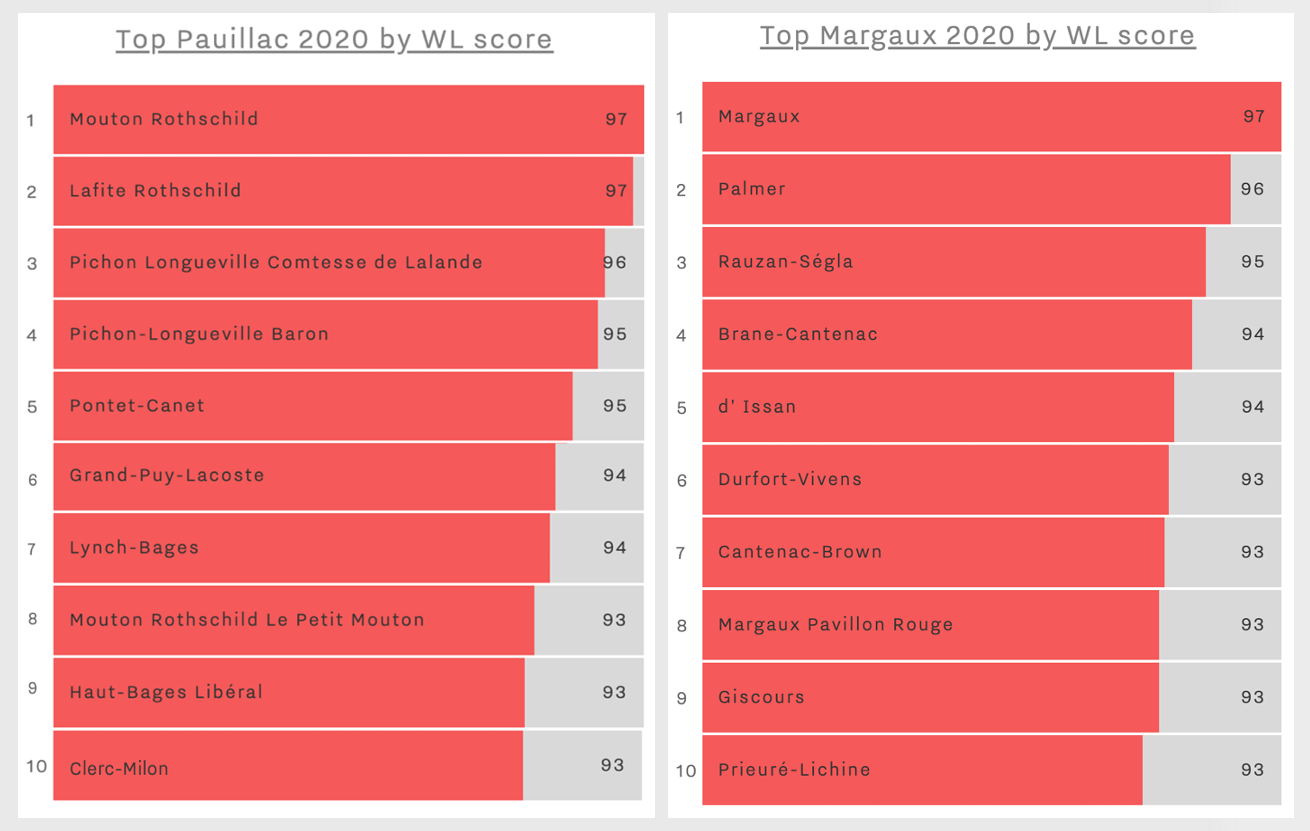
For the third year running, First Growths Mouton and Lafite dominate the Pauillac leader board with a joint WL score of 97. Super-seconds Pichon Comtesse and Pichon Baron follow suit with scores of 96 and 95, while Haut-Bages Libéral has climbed to joint-eighth place in 2020 (from ranking 18th in 2019). As explored in Part II of Wine Lister’s Bordeaux study, the estate is one of the top-15 wines to have seen its quality improve the most in 2020, compared to its average Quality score (explore key findings from the study here).
The Margaux appellation possesses the top-scoring wine of the vintage, Margaux 2020. Wine Lister CEO, Ella Lister, tasted the vintage and is confident that “This will age into eternity. And yet the texture is already so soft now.” For the second year in a row, Palmer secures the next-best place with a WL score of 96, while Rauzan-Ségla climbs eight places this year, into the third spot.
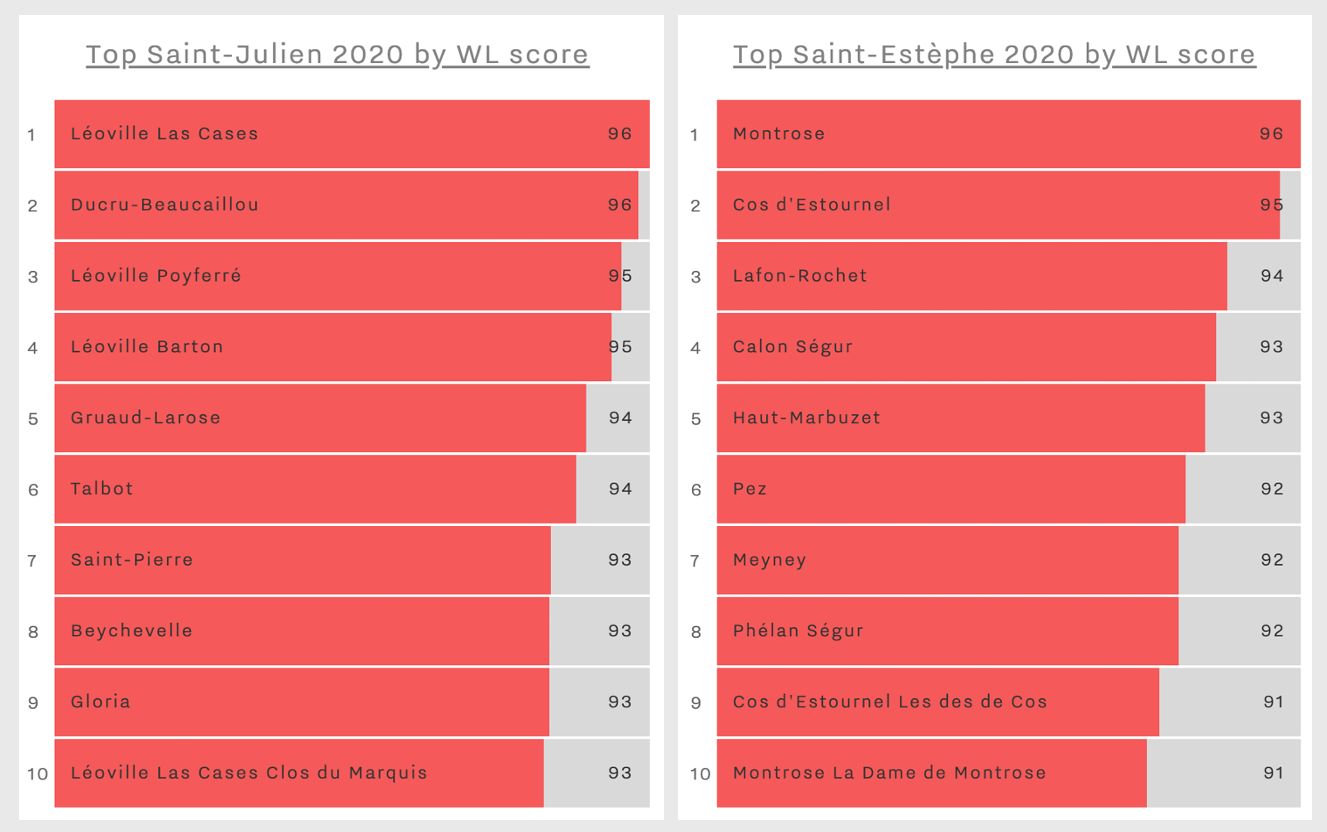
The top five Saint-Julien 2020s are in line with that of last year’s league, with Léoville Las Cases and Ducru-Beaucaillou sharing the top WL score of 96. Neighbours Léoville Poyferré and Léoville Barton follow suit with 95, while Gruaud-Larose once again achieves fifth place. Also appearing on the list of top 15 wines whose perceived quality in 2020 most exceeded their average, (Part II of Wine Lister’s Bordeaux Study) Talbot climbs four places since last year’s league, securing a WL score of 94 for the first time since its 1986 vintage.
Wine Lister Buzz Brand, Montrose, has another successful vintage in 2020, overtaking last year’s leader, Cos d’Estournel, to achieve the top place in the Saint-Estèphe league. Tasting in Bordeaux, Ella describes Montrose as having “silkiness in spades” and “beautifully integrated” wood on the palate. Lafon-Rochet climbs four spots to third place in 2020, having gained its highest WL score since 2016 (94). Entering the market last month (Thursday 20th May), the estate also features alongside Haut-Bages Libéral and Talbot as one of Wine Lister’s Quality score outperformers for the vintage.
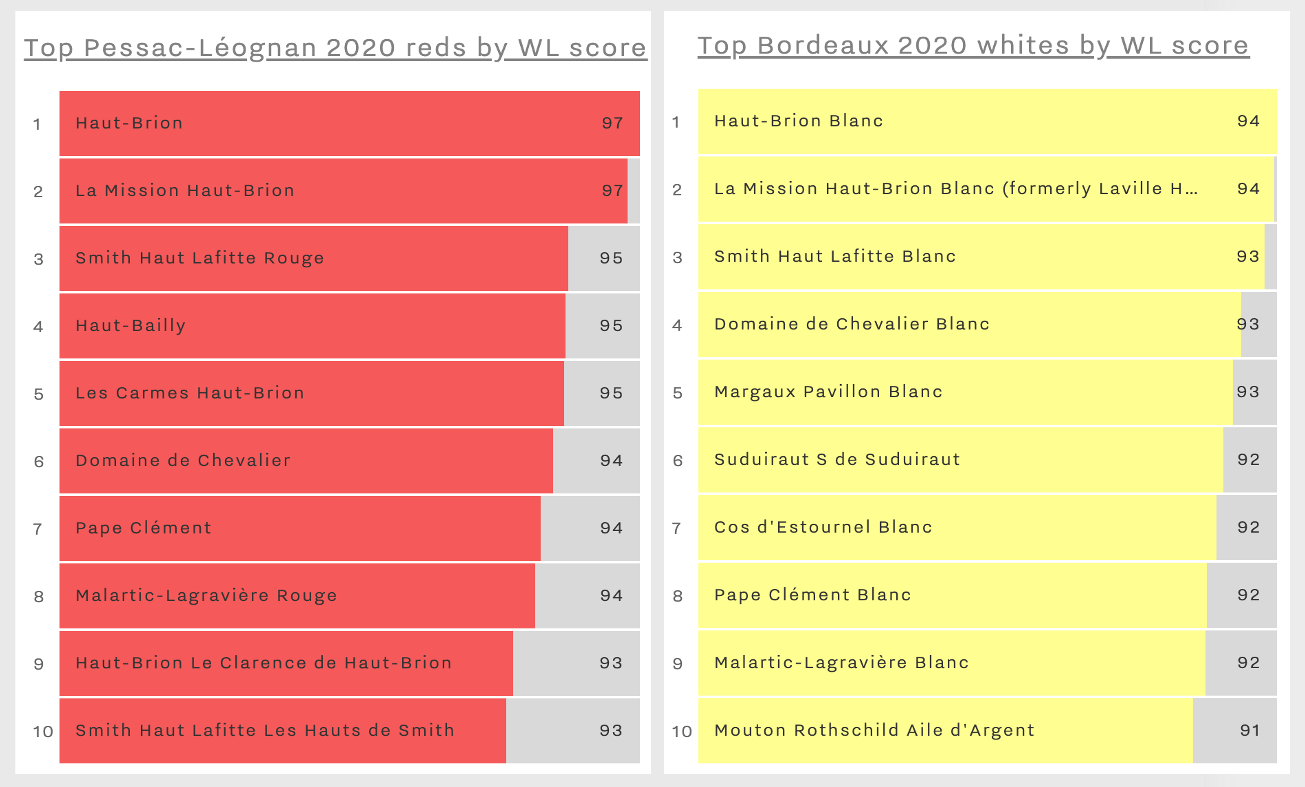
Haut-Brion and La Mission Haut-Brion perform notably well, once again achieving joint-first place in the league of top Pessac-Léognan 2020 reds. As in 2019, Smith Haut Lafitte and Haut-Bailly share third place, alongside the en primeur darling, Les Carmes Haut-Brion, whose WL score increases by one mark this year to 95. Second wines Les Hauts de Smith and Le Clarence de Haut-Brion enter the league with WL scores of 93, with the former gaining with its highest ever WL score in 2020.
Despite both scoring slightly down from 95 in 2019, Haut-Brion and La Mission Haut-Brion attain joint-first place for their whites as well as reds in 2020, achieving scores of 94 in the league of top Bordeaux whites by WL score. Tasting Haut-Brion Blanc, Ella notes it “Flexes its flinty muscles on the nose, with an almost Burgundian minerality accompanying its unmistakable Pessac green and yellow-fruit character.”
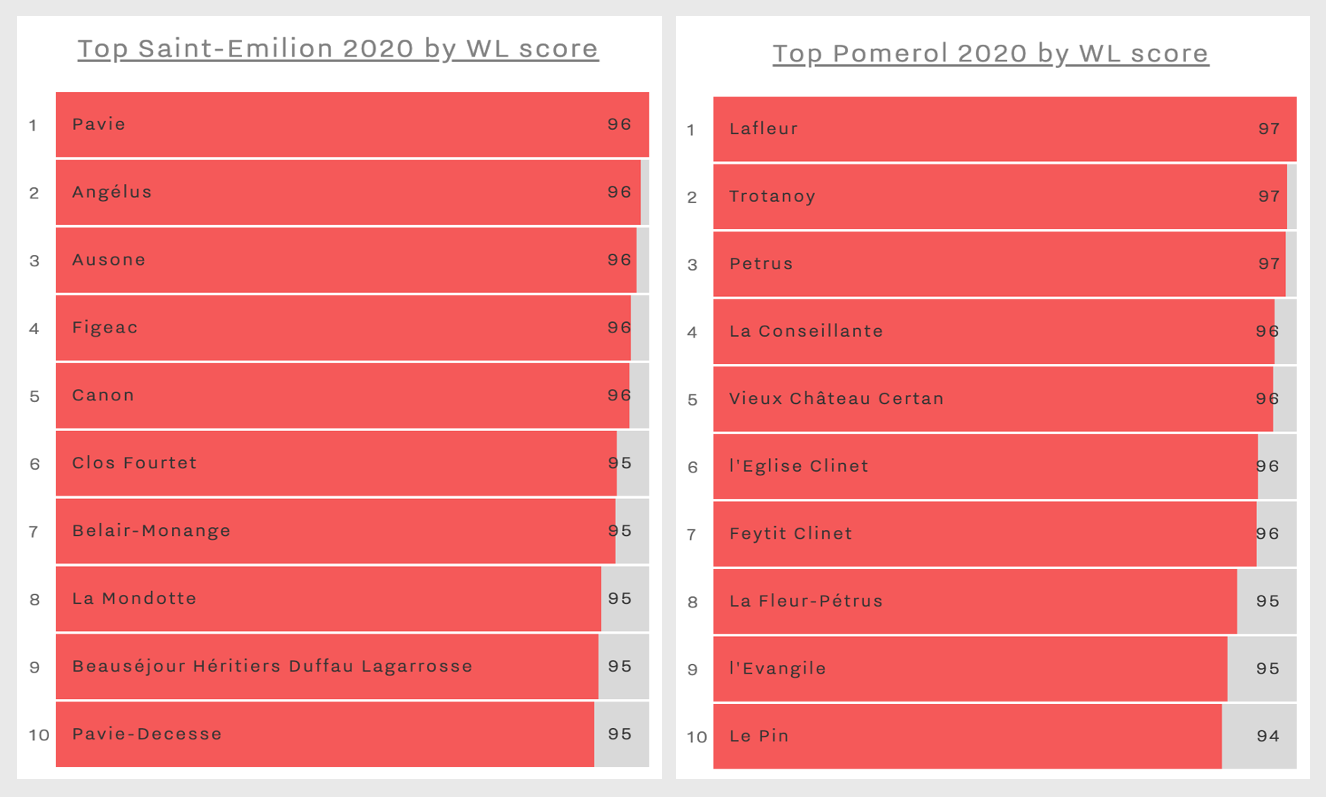
Pavie rises through the ranks from fourth place last year to lead Saint-Emilion’s league for the 2020 vintage, alongside Angélus, Ausone, Figeac, and Canon, whose scores of 96 are separated by fractional differences. Having been awarded 97-99 by Wine Lister partner critic, Antonio Galloni (Vinous), he describes it as, “Very clearly one of the wines of the year.” Clos Fourtet has climbed significantly this year, now standing in sixth position (up from the 17th spot in 2019).
As the only appellation to achieve a significantly higher average Quality score in 2020 than in 2019 (as explored in Part II of our Bordeaux Study), Pomerol takes the top spot for Quality score across all appellations in the latest vintage. Lafleur, Trotanoy, and Petrus share the leading WL score in its 2020 league (97), beating their score of 96 last year. Lafleur 2020 receives notable praise from the few critics who tasted in Bordeaux – Ella describes its mouthfeel simply as “out of this world”.
Click here to view all Wine Leagues. Pro users have access to a more extensive set of Leagues and can log in to access here.
Marking the end of this year’s Bordeaux 2020 en primeur campaign, the past two days (Thursday 24th and Friday 25th June) have seen the last First Growth to enter the market and some promising Right Bank releases, among others.
The last First Growth to be released, Mouton entered the market yesterday at £433 per bottle, 20% below current prices of the physical 2018. Completing a trilogy of top-scoring vintages, the 2020 earns high praise from critics, including Wine Lister’s partner critic, Antonio Galloni (Vinous), who awards 96-98 and describes “a wine of unreal elegance and finesse”. Tasting in Bordeaux, Wine Lister CEO, Ella Lister also praises the latest release, writing, “Everything is in perfect harmony,” adding that the wine is “Arterial in its focus, poise, and pure presence”. Mouton’s top quality in 2020, and it being the number one most searched-for wine in the world (according to searches on Wine Searcher), should encourage interest amongst collectors.
Sibling properties La Conseillante and Figeac were both released this morning, Friday 25th June, at £156 per bottle. Both wines sport scores suggesting a third consecutive triumph following on from 2019 and 2018.

Vinous’ Antonio Galloni gives La Conseillante 94-97 points, while his colleague Neal Martin awards 96-98 points, calling it a “deeply impressive and quite profound” wine, in which “The old “iron fist in a velvet glove” cliché rings true”. Ella adds to the commentary; “Wow – is this the purest, brightest, most precise La Conseillante yet under the auspices of Marielle Cazaux?”
Figeac’s 2020 release prices comes to market comfortably below what little remains of 2019, and 4% below 2018. Similarly well-scored, Galloni names Figeac 2020 “superb”, while Martin remarks simply, “a magnificent Figeac”. For the Wine Lister team and CEO, Ella, Figeac is one of the wines of the vintage. Ella describes a “gentle, distinguished” nose “with ripe red fruits and floral delicacy”, and a “juicy, profound, mouth-filling and feather-light” palate. She concludes, “The harmony is mind-blowing.”
Given the moderate price increase compared to other releases this week, and taking into consideration next year’s reclassification for Saint-Emilion, Figeac appears an attractive buy.
Excepting a handful of wines sold more or less on allocation-only bases (Petrus and Le Pin), the release of Vieux Château Certan, expected early next week, will conclude the Bordeaux en primeur 2020 campaign.
Watch this space for a retrospective review of best picks of the campaign, including our official list of MUST BUYS.
As we approach the end of this busy Bordeaux en primeur campaign, yesterday (Wednesday 23rd June) saw the release of the Clarence Dillon family wines, Saint-Éstephe superstar, Montrose, and promising Pessac-Léognan pick, Haut-Bailly.
 A family affair: Wine Lister CEO, Ella Lister tasted the Clarence Dillon family wines in Bordeaux
A family affair: Wine Lister CEO, Ella Lister tasted the Clarence Dillon family wines in Bordeaux
Haut-Brion released its red and white grands vins at £433 and £600 per bottle respectively, with both wines receiving strong praise from critics in 2020. The former gains 97-99 points from Wine Lister’s partner critic Antonio Galloni (Vinous), who notes “The 2020 Haut-Brion is shaping up to be one of the wines of the year. […] Wow.” Wine Lister CEO, Ella Lister was also impressed, describing “Focussed purple fruits, with a fresh lift of aloe vera, pepper, and fading peonies” on the nose, with “Classical flavours of cassis and violet, [and] a beautiful, beamish balance” on the palate.
Ella also provides a positive perspective on the latest release of Haut Brion Blanc, describing an “almost Burgundian minerality” on the nose, a “golden” palate. It gains the joint-highest WL score of all dry Bordeaux whites in 2020, tying for first place with its cousin, La Mission Haut-Brion Blanc.
La Mission Haut-Brion’s red and white entered the market yesterday at £252 and £480 per bottle, respectively. Gaining an impressive score of 97-99 from Neal Martin (down from the potential 100-point score of 98-100 in 2019), La Mission Haut-Brion 2020 is described by the critic as “An enthralling wine in the making from Jean-Philippe Delmas and his team”. Ella is also impressed with the latest release, noting “brooding, poised aromas of pomegranate and fig” on the nose, with a “layered and expressive” palate. Falling under the current market price of the 2018 and 2019 (whose price has increased around 63% since its release), while sporting similar average critics scores to the 2015 and 2016 vintage, this could be an attractive buy.
Outside of the Clarence Dillon clan, Montrose entered the market at £128.35 per bottle, having been well received by the few critics who tasted in Bordeaux this year (the estate was among those that did not send samples abroad). Wine Lister’s partner critics, Bettane+Desseauve award 98 points on their new scale of 100 points, while James Lawther for JancisRobinson.com gives 18+ points. Tasting in Bordeaux, Ella notes that “The fruit this year is ethereal. Luminous, racy, and as with the second wine, with an incredibly gentle touch” on the nose, whilst the palate “has that Montrose silkiness in spades”. Gaining the highest WL score of Saint-Estèphe 2020s (96), this may well see demand from fans of the estate and its appellation.
Haut-Bailly also released yesterday at £96 per bottle, having gained positive scores of 95-97 from both Antonio Galloni and Neal Martin. Hosting a virtual tasting of the estate’s 2020s for our London office, owner Véronique Sanders told us that the château confronted extreme climatic conditions last year, akin to the past three vintages, which have all produced top quality wines. Indeed, tasting at the estate, Ella found Haut Bailly’s Grand Vin to be “poised, savoury, and relaxed” on the nose, with “a lovely weight, and trademark ribbon mouthfeel”.
As we find ourselves in the peak of this year’s en primeur activity, Tuesday morning (22nd June) saw a wave of releases from the Médoc and beyond, including wines from First Growth Margaux, its popular neighbour Palmer, and fellow biodynamic trailblazer, Smith Haut Lafitte.
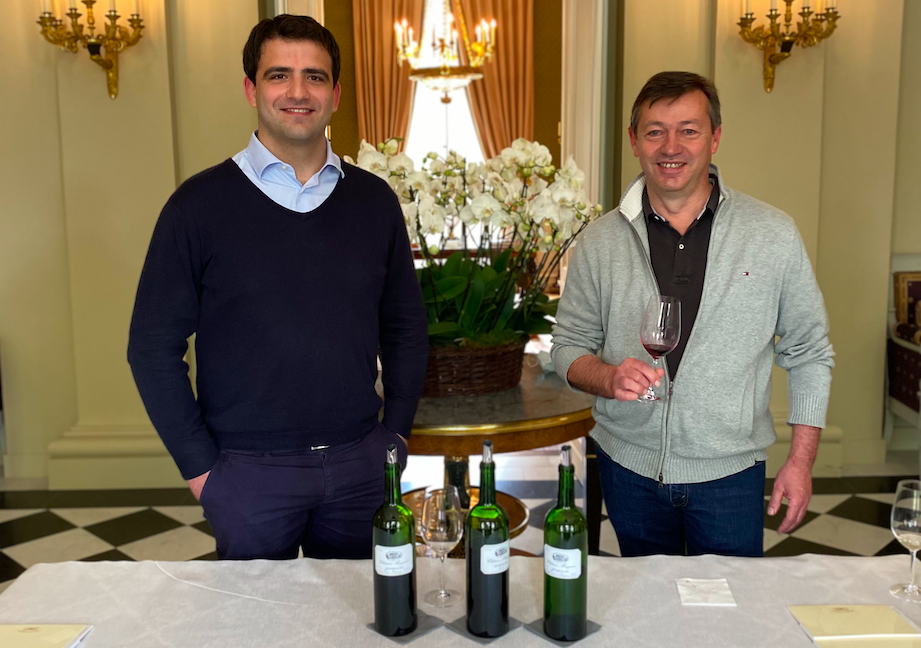 Moments at Margaux: the First Growth released its 2020 on Tuesday (22nd June) at £433 per bottle
Moments at Margaux: the First Growth released its 2020 on Tuesday (22nd June) at £433 per bottle
Smith Haut Lafitte kicked off the release rush, entering the market at £96 per bottle. The 2020 receives top scores across the board, with Wine Lister’s partner critics, Antonio Galloni and Neal Martin (Vinous) each giving 95-97 points, and the latter deeming it “an outstanding effort”. Tasting with co-owner, Florence Cathiard at the property, Wine Lister CEO, Ella Lister, describes “playful black fruit, dark chocolate, and black liquorice” on the nose, and a “fine-boned but monstrous tannic structure” on the palate.
Joining its red offering (at the same price), Smith Haut-Lafitte’s white also receives strong scores from critics, including 17.5 points from Jancis Robinson, who calls it “a real triumph”. Ella observes that the 2020 vintage is a perfect example of why Smith Haut-Lafitte is so famous for its blanc sec, finding “a subtle, flirtatious nose of white pepper, lime and pure white fruit”, and a “rich, creamy texture” on the palate. Both Smith Haut Lafitte 2020 rouge and blanc have special edition labels designed to celebrate the 30th vintage under Florence and Daniel Cathiard, as well as 655 years of the property.
Moving over to the Médoc, Margaux 2020 released yesterday at £433 per bottle, having been widely considered as the wine of the vintage. According to scores from Wine Lister’s partner critic panel, the First Growth does indeed top the 2020s, gaining the highest WL score of the vintage. Antonio Galloni and Neal Martin both award Margaux 97-99 points, with the former calling it “very clearly one of the wines of the vintage in 2020″. Tasting at the property in Bordeaux, Ella describes an “intensely rich, concentrated” nose, and a palate that is “off-the-charts potent in terms of fruit and acidity”. Wine collectors will likely be desperate to get their hands on this.
Margaux’s second wine, Pavillon Rouge, and dry white, Pavillon Blanc were also released, at £138 and £180 per bottle, respectively. Ella praises both wines in 2020, describing an “all-round beautiful balance and intensity of fruit” in the red, and admiring the “really rich, mouthcoating texture” of the white – “almost a Chardonnay-esque opulence”.
Popular en primeur pick, Palmer also entered the market at £240 per bottle. Speaking to Wine Lister in October, Managing Director, Thomas Duroux explained that while “négociants would have liked a vintage with high volume and lower prices, the 2020 will be small”, yet nonetheless “rich and exuberant”. Palmer 2020 receives strong scores from the few critics who have tasted it (having maintained its policy of not sending samples). James Lawther for JancisRobinson.com awards it 18+ points, while Ella comments on the wine’s “exquisite texture”, hailing it “like brushed Indian silk”.
 The top 20 leading sibling wines by Wine Lister value score
The top 20 leading sibling wines by Wine Lister value score










 A family affair: Wine Lister CEO, Ella Lister tasted the Clarence Dillon family wines in Bordeaux
A family affair: Wine Lister CEO, Ella Lister tasted the Clarence Dillon family wines in Bordeaux